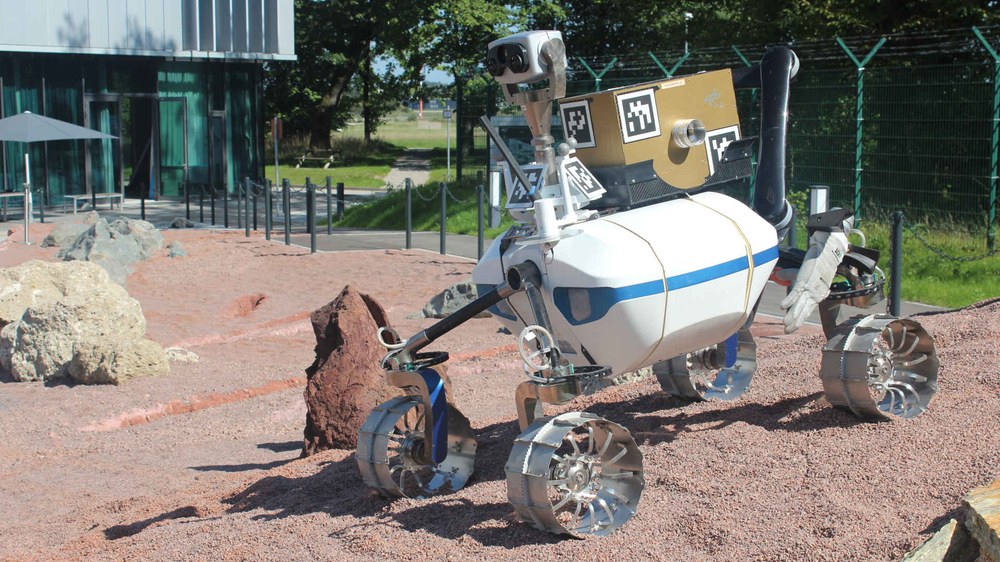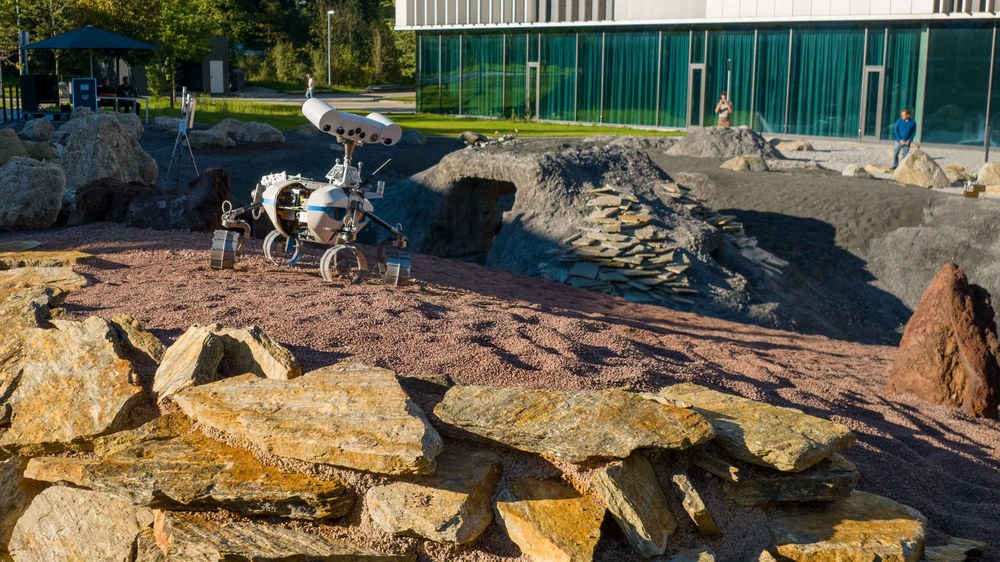Moon and Mars test site for robotic missions



- On 26 September 2023, the DLR Robotics and Mechatronics Center in Oberpfaffenhofen opened its Moon-Mars test site.
- Among other things, the test site allows researchers to test their exploration robots at any time.
- Focus: Spaceflight, robotics, Moon, exploration
The Moon and Mars are stated targets of European and international space exploration. However, before humans embark on these journeys, robots will explore inhospitable areas, develop local resources and prepare for the landing of astronauts as comprehensively as possible. Exploration missions with autonomous mobile robots will therefore increase significantly in the coming years. To facilitate this, on 26 September 2023 the German Aerospace Center (Deutsches Zentrum für Luft- und Raumfahrt; DLR) inaugurated a special research facility in Oberpfaffenhofen. The Moon-Mars Test Site, which is operated by the Robotics and Mechatronics Center (RMC), offers ideal conditions to prepare robots for planetary exploration tasks.
Until now, testing only took place in the laboratory or far away in inhospitable environments such as on Mount Etna. Now, researchers can test their robots right next to the institute building and 'expose them to real conditions' at any time. In addition to more efficient development, the facility will allow them to test cooperation between different types of robots and complex mission scenarios. In future, this scientific facility will also be available to partners from industry and research. With the new test site, DLR is building on its many years of experience in exploration robotics in order to continue strengthening Germany's leading role in international trade.
"I am convinced that the RMC Moon-Mars Test Site will give a strong boost to exploration robotics. I am particularly looking forward to using our robots in the future to explore places that have so far been inaccessible to humankind," explained Alin Albu-Schäffer, Director of the DLR Institute of Robotics and Mechatronics. The German-French rover IDEFIX, built in cooperation with the French space agency CNES, will be the first to start exploring the Martian moon Phobos next year as part of the Japanese MMX mission. This space-qualified technology forms the basis for the flight models of other moving, walking or crawling robots that the RMC is currently testing in the new facility.
1500 square metres with a link to space
The volcanic and cave landscapes of Mars and the Moon are reproduced over 1500 square metres. A tunnel, a crater, various hills, rocks, gullies and sand dunes replicate the extraterrestrial environments, with two thirds devoted the Moon and one third to Mars. The site thus fulfils all relevant geological specifications and includes various subsoils such as basalt, lava rocks, fine gravel and suevite from the Nördlinger Ries. In addition, the new facility is connected to the already existing 'Test Site for Planetary Rovers'. The DLR Institute of System Dynamics and Control, which is part of the RMC, had set up a test environment in 2021 to train the DLR rover Scout for particularly rough terrain. The facilities, which are located opposite one another, are now connected by a trail and are shared by the RMC sister institutes.
This opens up a variety of testing possibilities for wheel- and leg-based robotic locomotion, autonomous navigation, multimodal object recognition and mobile manipulation (where a robot moves to a target and performs some task there with a 'hand'). In collaboration experiments, researchers will test how robots with different abilities work together to create a map or solve other complex tasks independently. An optical tracking system allows reference measurements that create common standards for external users as well.
The external laboratory is also connected to the IT infrastructure of the RMC. Thus, there is a link to the German Space Operations Center (GSOC) and the International Space Station ISS. In the future, telerobotics experiments in which a crew member commands the robots on the test site from the ISS are conceivable. Cooperation with the LUNA Moon simulation facility in Cologne, a joint project between DLR and the European Space Agency (ESA), ensures special closeness to the Moon. The DLR Institute of Robotics and Mechatronics is currently developing two identical rovers for tests in Oberpfaffenhofen and Cologne.
While developing technologies for spaceflight and the exploration of Mars and the Moon, DLR always has its eye on Earth as well. For example, in the AHEAD project, the RMC uses space robotics to develop remote-controlled off-road vehicles for transporting humanitarian aid. At the RMC Moon-Mars Test Site, researchers will continue to advance technological developments in robotics. DLR is expanding its technological and operational expertise for future missions and applications.
